The panel of The princess Eudoxia in front of the tomb of Saint Stephen of the altarpiece of Saint Stephen of Granollers represents the Roman Emperor Theodosius II and Empress Eudoxia leading their daughter, the princess Eudoxia, possessed by the devil, in front of the relics of Saint Stephen. It shows the moment of the miracle, when the devil comes out of the mouth of the princess. A mutilated pilgrim is also represented, waiting for a miraculous healing through the intercession of the saint.
The application of the colour
The analytical study of the samples and the thorough examination of the work allow us to know some more aspects of the methodology of the work of the painter. Once the surface of the panel was plastered, the drawing was carried out, either by charcoal, brush or carved, and after this the metal sheets were applied, which in this case have been identified as being fine gold or silver.
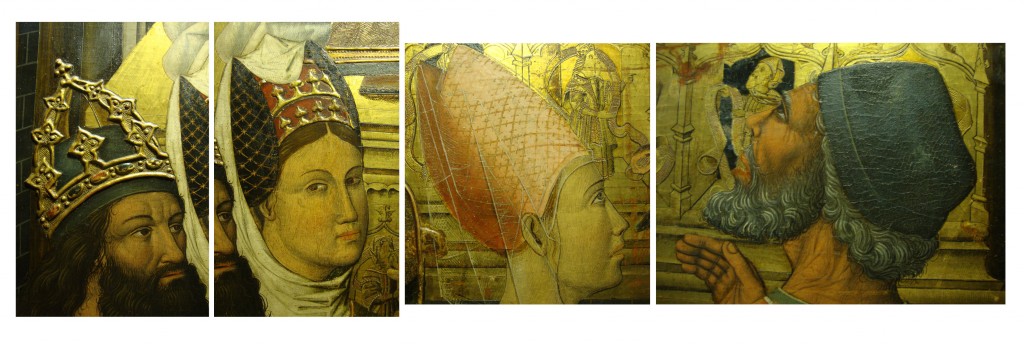
After the metal sheets, the colours were applied. With regard to the clothing, each garment was coloured in an individual way. For example, in the dalmatic of Theodosius II, vermillion in colour, the belt was left unpainted and was coloured afterwards in light blue. For this reason, under the blue there are not remains of red. The same happens with the short cape of the pilgrim, which was coloured leaving to a later stage the drawing of the bag which was painted afterwards in yellow.
The clothing of the five characters and how the artist achieved the colours
The basic palette of colours of the garments is formed by six colours: vermillion, carmine, blue, yellow, white and green; it also comprises black, which hasn’t been studied in an individualised way.
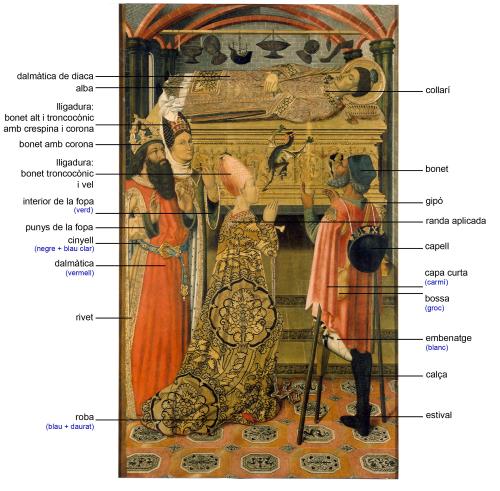
- Theodosius II
The Emperor wears a blue hat on his head, of silk, with a golden crown produced in stucco relief to give it volume; the gold is done with fine gold leaf. He is dressed in a bright red dalmatic, for which, according to the chemical analyses, the painter, on a plaster preparation, used a compound of mercury, cinnabar or vermillion, interspersed with organic colouring, crimson lake, as can be appreciated in the cross-section of the sample. It is worth highlighting the great care taken with the grind of cinnabar and the deposition of the homogeneous layers. The shades were achieved by means of the use of carmine.
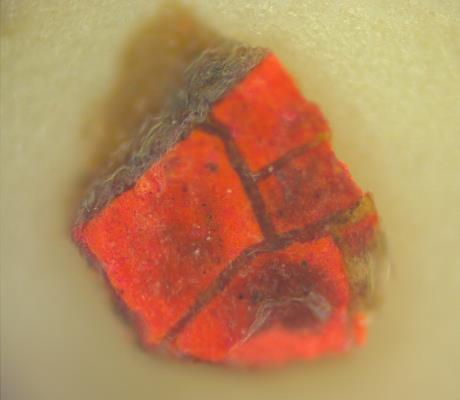

The lining of the dalmatic is ermine, much appreciated and used by wealthy people. The dalmatic was riveted by a strip with golden decorations, made of stucco relief. Under the dalmatic, the Emperor is wearing a cassock, a sort of long and loose tunic. Notable are the cuffs of the tunic, where you can appreciate the hairs delicately painted with the tip of the brush. Around his waist he wears a light blue belt with golden decorations. The pigment has been identified as a copper compound, azurite, mixed with a large amount of lead white. The cross-section of the sample of the blue is made up of five layers: gesso ground, primer, lead white, azurite and lead white, and black carbon in the upper part, which corresponds to the decorative drawing. The blue colour is worth noting, thicker than the others, in which the grains of azurite, of heterogeneous morphology and barely crushed, are mixed with the lead white.
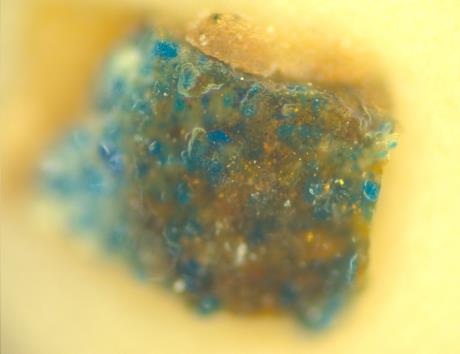

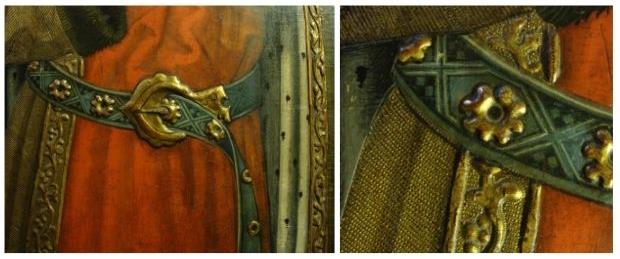
- Eudoxia
The Empress appears half hidden in the background. She is wearing a head covering: a high and tapered hat with a net and crown, with touches of white and linen fabric. The crown is golden and made with the same technique as the one of her husband. As a coat, she wears a cassock with wide green sleeves, riveted with golden stucco relief. Of the cassock we can only see that of the left-hand side, which lets us see the completely golden gown.
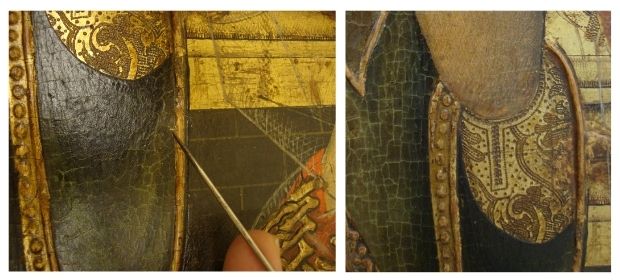
In the cross-section of the sample of the cassock four pictorial layers have been identified made up of the mix of a green of copper compound (possibly the verdigris) with lead-tin yellow, and with lead white, only the proportions change. The sample has been taken from an area close to the gold trim, and for this reason, the remains of elaborate gold leaf have been found, as can be seen in the image 11, with the clay bowl or preparation to receive the metal sheets placed on the plaster preparation.
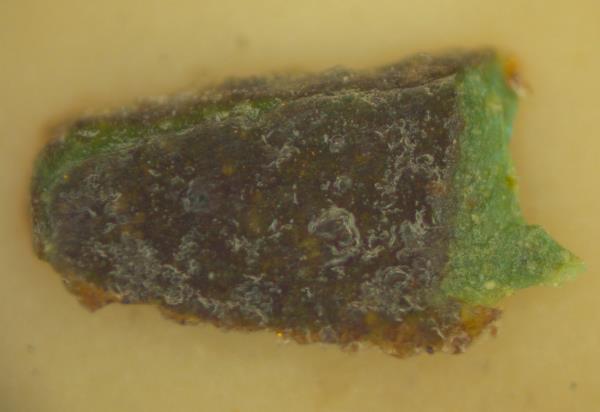
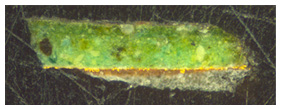
- The Princess Eudoxia
She has her head covered with a headdress, the same as her mother’s, with a high and tapered hat, carmine in colour with degradations, decorated with reticulated lines done with the tip of the brush. The hat is completed with a subtle transparent veil which delicately falls as far as the shoulders. She is wearing a long dress with a sumptuous tail that imitates velvet, worked and ringed in gold. The neckline is adorned with applied lace. The dress is completely golden with elaborate gold leaf, burnished and decorated with the technique of punching. It is enriched with a polychrome in which pomegranate flowers, with the stems and leaves of the plant, are reproduced. Currently, these plant motifs have undergone a chromatic alteration and a black colour can be perceived, when originally they were blue. These plant drawings on the clothing, observed with grazing light, take on volume, because the pigment was applied with a brush full of pictorial material. These ornamentations were inspired by textile repertoires, and needless to say that they were luxury and expensive fabrics. Nowadays, in the Design Museum of Barcelona a fragment of fabric from the 15th century can be contemplated with identical pomegranates.
![(12) Images of the template of the drawing of the pomegranate flower in blue. Photo: Núria Prat i Grau. (13) Fragment of fabric. Silk and gold thread, velvet cut from just one piece, worked and ringed with gold on taffeta, 126 x 60.5 cm. Italy or Valencia, second half of the 15th century. Acquired with the Pascó Collection in 1914 (MTIB 28232). Photo: Núria Prat i Martín Ros, R.M., “Fragment de teixit”, La Barcelona gòtica, Barcelona, Museu d’Història de la Ciutat, 1999, p. 211-212 [catálogo de exposición]](https://blog.museunacional.cat/wp-content/uploads/Imatges-de-la-plantilla-del-dibuix-de-la-flor-de-la-magrana-en-blau.jpg)
The chemical analyses of the sample have identified different strata: the red-brown coloured bowl, a clay formed mostly of iron oxides, was applied to the gesso ground. The blue chromatic layer is thick and is formed of azurite grains of different sizes, a copper compound that doesn’t require an energetic grinding because if it is ground too much, the blue fades.
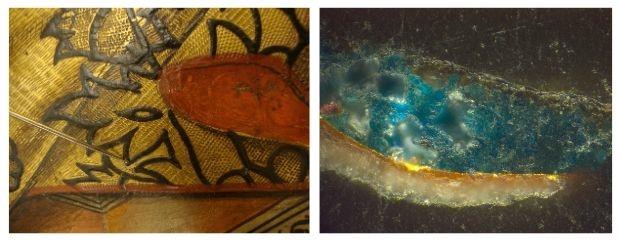
- The Pilgrim
He is dressed in the way of humble people, with a doublet of adjusted sleeves and a blue hat on his head, both made of wool. In the 15th century the hat was worn all the time. Normally it was made of wool, even though the more luxurious ones were made of silk or velvet. He is wearing a simple short cap, carmine in colour, with different shades which highlight the volumes of the draping. In the cross-section of the sample analysed, which corresponds to the hatching of the of the piece of clothing, six layers have been identified, constituted by organic colouring, the crimson lake, mixed with lead white, with different proportions and thicknesses so as to achieve the chromatic degradations and the different tones and placed on an ochre layer of primer and gesso ground.
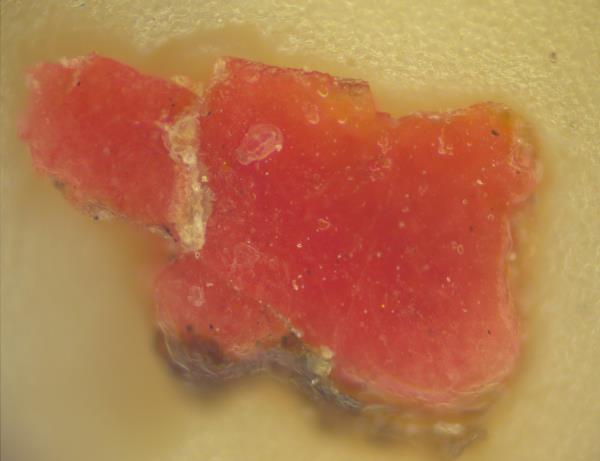
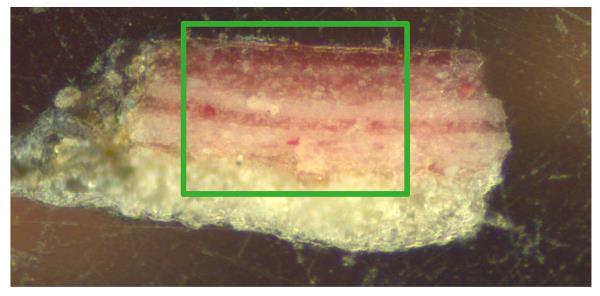
The man is also wearing a hanging cap, to keep off the sun, with the scallop shells of Saint James, a symbol of pilgrimage. It is also worth pointing out the keys of Saint Peter, because they indicate that the relics of Saint Stephen were in Rome, the place where the scene takes place. On the strap, we can see a bag, adorned with some red and orange lines. The yellow colour of the bag has been painted with lead-tin yellow mixed with lead white, on the gesso ground. In the final layer the minium was added to achieve a orangey tone.
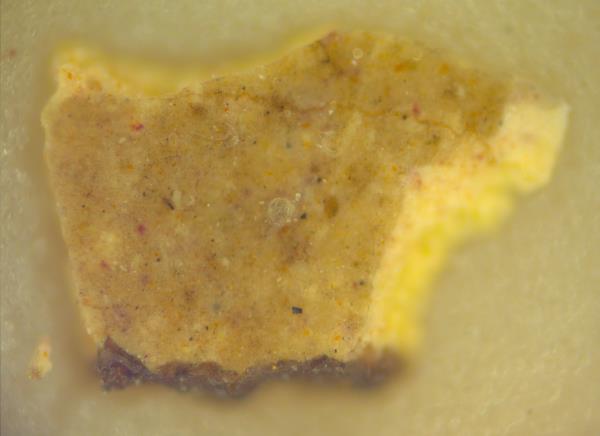
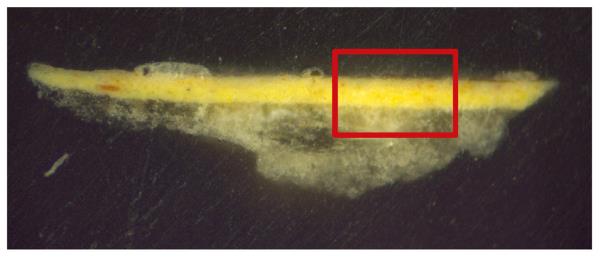
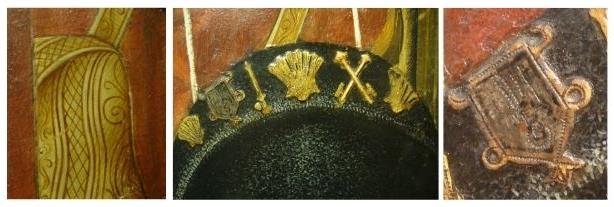
Very plain black stocking and boots complete the pilgrim’s outfit. The bandage on the left leg is white with some grey lines. The cross-section of this sample shows that it is simple: a pictorial layer of lead white subdivided in two sub-layers. In the last, the lead white is mixed with particles of black carbon.

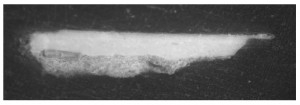
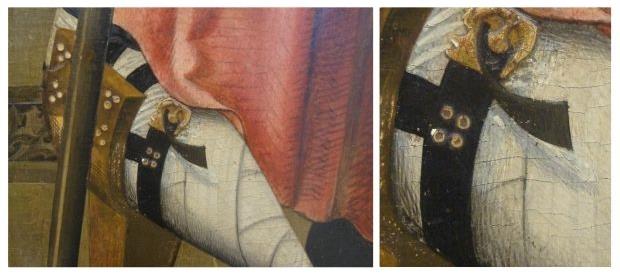
- Saint Stephen
He appears in the clothes of a deacon of worked velvet fabric ringed with gold. The same execution technique has been applied to the dalmatic as that of the clothing of the Princess Eudoxia: it is all golden with gold leaf, done in water, burnished and decorated with punching. On the gold leaf the plant ornamentation has been painted in tempera, with the tip of the brush. There is again the pomegranate motif, a recurring decorative pattern of the Gothic, but this time more evolved: it no longer has the stems and the fruit is more open, like other models of fabrics of the time. Under the dalmatic, the the Saint is wearing an alb that, in the areas of the feet, has an adornment with some applications of velvet fabric, worked and ringed with gold. He rests his head on a pillow with braid and a tassel.

In the second part of this post we will develop in greater depth the use of subsection drawing by the artist in the execution technique used.
References (in Catalan)
Garriga Riera, J., “L’antic retaule major de sant Esteve de Granollers, dels Vergós”, Lauro. Revista del Museu de Granollers, 15, 1998, p. 15-35
Martín Ros, R.M., “Indumentària. El vestit gòtic. El segle XIV”, “l’aparició del concepte moda cortesana. El segle XV”, “Renaixement i Barroc”, a Art de Catalunya 12. Disseny. Vestit. Moneda i medalles, Barcelona, 1997, p. 161-187.
Ruiz Quesada, F., “Els Vergós i el Retaule de Sant Esteve de Granollers. Un nou apropament a la seva complexitat” Entra a l’església gòtica de Granollers, Barcelona, 1997, p. 74-81 (exhibition catalogue).
Author’s note: I would like to thank Rosa M. Martín i Ros for her advice and assessment about clothing and Antoni Morer i Munt, PhD, for the chemical analyses.
Restauració i Conservació Preventiva







